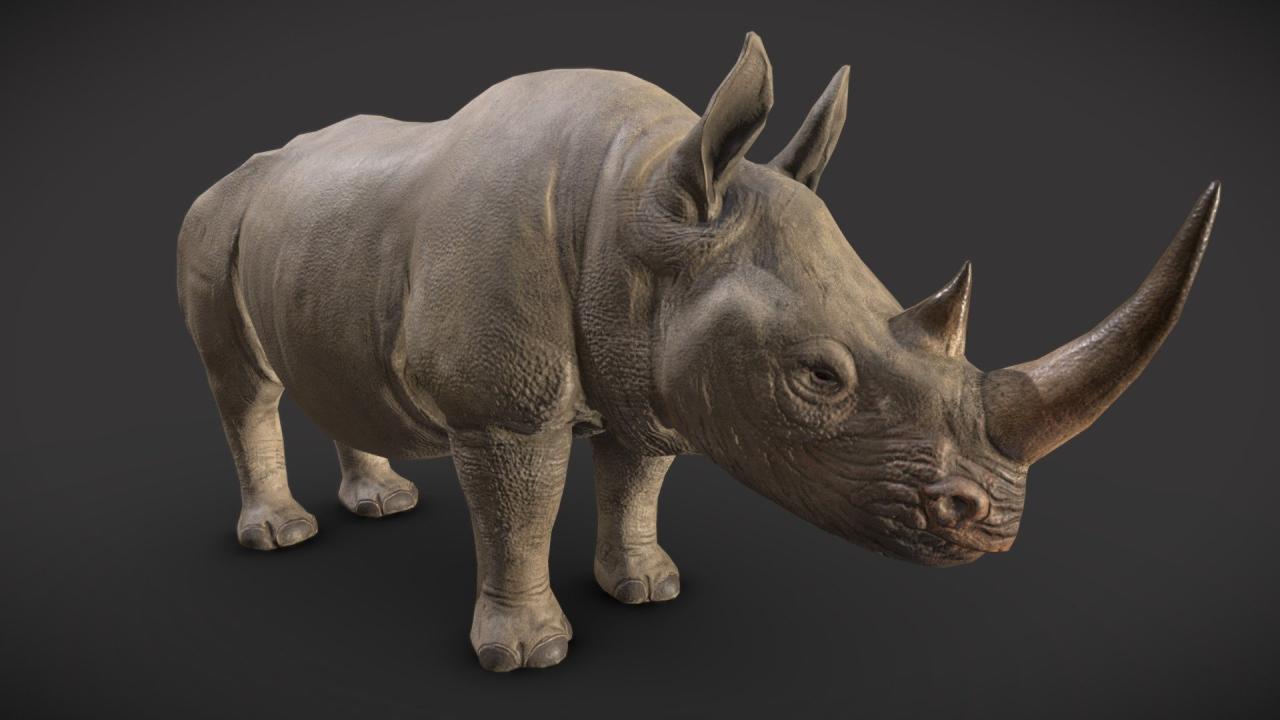Rhino 3D is a powerful and versatile 3D modeling software used across a wide range of industries, from product design and architecture to jewelry and animation. Its history spans decades, evolving alongside technological advancements and user demands, resulting in a robust platform that caters to both beginners and seasoned professionals. Rhino 3D’s intuitive interface and comprehensive features make it an ideal choice for creating intricate and detailed 3D models.
Table of Contents
This guide delves into the world of Rhino 3D, exploring its history, key features, applications, and modeling techniques. We’ll guide you through the software’s interface, demonstrate common workflows, and uncover the power of plugins and extensions. Whether you’re a seasoned professional or just starting your 3D modeling journey, this comprehensive guide will equip you with the knowledge and skills to harness the full potential of Rhino 3D.
Rhino 3D Applications

Rhino 3D, a powerful and versatile 3D modeling software, has found widespread use across numerous industries, proving its adaptability and efficiency in various design and engineering fields. Its intuitive interface and robust features make it a valuable tool for professionals seeking to create intricate models, complex surfaces, and precise geometries.
Industrial Design
Rhino 3D is a popular choice for industrial designers, enabling them to conceptualize and visualize products ranging from consumer goods to automotive components. Its ability to handle complex curves and surfaces allows designers to create aesthetically pleasing and functional designs.
- Product Design: Rhino 3D’s versatility makes it suitable for designing various products, including furniture, electronics, toys, and household appliances. Designers can create detailed models, explore different design iterations, and refine product aesthetics.
- Automotive Design: Rhino 3D is widely used in the automotive industry for creating car bodies, interiors, and exterior components. Its advanced surfacing tools allow designers to achieve complex shapes and intricate details, ensuring both aesthetics and aerodynamic efficiency.
Architecture
Rhino 3D has become an indispensable tool for architects, enabling them to create detailed building models, explore different design possibilities, and generate construction drawings. Its ability to handle complex geometries and integrate with other software applications makes it a powerful design platform.
- Building Design: Architects utilize Rhino 3D to model buildings, from simple structures to complex multi-story complexes. The software allows for detailed modeling of facades, interiors, and structural elements, ensuring accuracy and consistency.
- Landscape Architecture: Rhino 3D plays a crucial role in landscape design, enabling architects to create detailed site plans, model terrain features, and design outdoor spaces. Its powerful tools allow for the integration of plants, water features, and other elements to create visually appealing and functional landscapes.
Jewelry Design
Rhino 3D’s precision and ability to handle intricate details make it a preferred choice for jewelry designers. The software allows for the creation of detailed models, the exploration of various design concepts, and the generation of production-ready files.
- Ring Design: Rhino 3D is used extensively in ring design, allowing jewelers to create unique and intricate designs, including complex settings and intricate details.
- Pendant Design: The software’s ability to handle complex shapes and surfaces makes it ideal for designing pendants with intricate patterns and textures.
Other Applications
Rhino 3D’s versatility extends beyond traditional design fields, finding applications in diverse areas such as:
- Medical Modeling: Rhino 3D is used to create detailed anatomical models for medical research, surgical planning, and patient education.
- Animation and VFX: Rhino 3D’s modeling capabilities make it a valuable tool for creating realistic 3D models for animation and visual effects.
- Game Design: Game developers utilize Rhino 3D to create detailed models for environments, characters, and props, enhancing the visual appeal and realism of games.
- Reverse Engineering: Rhino 3D can be used to create digital models from existing physical objects, enabling designers to understand the design process and create new versions.
Rhino 3D Plugins and Extensions
Rhino 3D is a powerful 3D modeling software that offers a wide range of tools and functionalities. However, its capabilities can be further expanded by utilizing plugins and extensions developed by third-party developers. These add-ons provide specialized features and functionalities that enhance Rhino’s workflow and empower users to tackle complex design challenges.
Popular and Essential Plugins
Plugins and extensions add specialized features to Rhino 3D, extending its functionality beyond its core capabilities. Here is a list of popular and essential plugins categorized by their functions:
Modeling
- T-Splines: This plugin allows users to create and manipulate NURBS surfaces with more control and flexibility, enabling the creation of organic shapes and complex geometries.
- Grasshopper: A visual scripting environment that allows users to create parametric models and automate complex design processes. It provides a visual programming interface that enables users to connect different components and create intricate workflows.
- SubD: This plugin introduces subdivision surface modeling capabilities to Rhino, allowing users to create smooth, organic shapes with high-resolution detail.
Rendering
- V-Ray for Rhino: A powerful rendering engine that delivers photorealistic images and animations. It offers advanced features like global illumination, physically based materials, and high-quality rendering capabilities.
- Corona Renderer: Another popular rendering engine that provides fast and efficient rendering with a user-friendly interface. It supports physically based materials, advanced lighting techniques, and high-quality output.
- Maxwell Render: This plugin offers a physically accurate rendering engine that simulates light and materials in a realistic way. It produces high-quality images and animations with accurate color and lighting.
Analysis
- Rhino.Inside.Revit: This plugin allows users to work seamlessly between Rhino and Revit, enabling the transfer of geometry and data between these two popular design software.
- Karamba3D: A structural analysis plugin that enables users to perform structural simulations and analyze the behavior of buildings and other structures.
- Ladybug Tools: A plugin for environmental analysis that allows users to simulate energy performance, daylighting, and other environmental factors.
Benefits and Limitations of Using Plugins
Plugins and extensions offer numerous benefits to Rhino 3D users, including:
- Enhanced Functionality: Plugins expand Rhino’s capabilities by providing specialized tools and features that address specific design needs.
- Increased Efficiency: Plugins can automate repetitive tasks, streamline workflows, and improve overall productivity.
- Customization and Flexibility: Users can tailor their Rhino environment to meet their specific requirements by selecting and installing relevant plugins.
However, there are also limitations associated with using third-party plugins:
- Compatibility Issues: Plugins may not always be compatible with the latest version of Rhino or other software, leading to potential conflicts or errors.
- Learning Curve: Some plugins require a learning curve to master their features and functionalities.
- Support and Maintenance: Plugins may not always receive regular updates or support, which could lead to compatibility issues or security vulnerabilities.
Installing and Managing Plugins
Installing and managing plugins in Rhino 3D is a straightforward process. Here are the steps involved:
- Download the Plugin: Download the plugin from the developer’s website or a trusted plugin repository.
- Install the Plugin: Install the plugin by following the instructions provided by the developer. This typically involves extracting the plugin files to a specific directory.
- Load the Plugin: Load the plugin within Rhino by navigating to the “Plugins” menu and selecting the plugin you want to activate.
- Manage Plugins: You can manage installed plugins by accessing the “Plugin Manager” in the Rhino settings. This allows you to enable, disable, or uninstall plugins.
Rhino 3D for Architecture and Interior Design

Rhino 3D has become a popular choice for architects and interior designers due to its powerful modeling capabilities, flexibility, and integration with other design software. It allows professionals to create complex designs, explore different ideas, and visualize their projects in stunning detail.
Notable Architectural Projects Designed with Rhino 3D
Rhino 3D has been used in the design of numerous iconic architectural projects worldwide. Here are a few examples:
| Project | Architect | Location | Description |
|---|---|---|---|
| Heydar Aliyev Center | Zaha Hadid Architects | Baku, Azerbaijan | A cultural center featuring a distinctive, fluid, and dynamic architectural style. |
| The Broad | Diller Scofidio + Renfro | Los Angeles, USA | An art museum with a unique honeycomb-like facade and a vast, open interior. |
| Guggenheim Museum Bilbao | Frank Gehry | Bilbao, Spain | A museum renowned for its innovative use of titanium panels and its distinctive, deconstructivist design. |
Rhino 3D Features and Tools for Architectural Design
Rhino 3D provides a comprehensive set of tools specifically designed for architectural design, including:
- NURBS modeling: Rhino 3D’s core modeling technology allows for the creation of smooth, organic shapes and complex geometries, ideal for architectural designs.
- Surface modeling: Rhino 3D offers advanced surface modeling tools to create intricate and detailed surfaces, such as facades, roofs, and interior elements.
- Solid modeling: Rhino 3D enables the creation of solid objects, including walls, floors, and furniture, for accurate representation and analysis.
- Rendering: Rhino 3D integrates with various rendering engines, allowing architects to create high-quality visualizations and presentations of their designs.
- Analysis tools: Rhino 3D includes tools for analyzing the performance of designs, such as energy efficiency, daylighting, and structural analysis.
- Collaboration tools: Rhino 3D supports collaboration through its ability to import and export various file formats, enabling seamless communication between architects and other design professionals.
Rhino 3D for Collaboration Between Architects and Interior Designers
Rhino 3D facilitates seamless collaboration between architects and interior designers by providing a shared platform for design development and communication. This includes:
- Shared models: Architects and interior designers can work on the same Rhino 3D model, ensuring consistency and accuracy in the design process.
- Data exchange: Rhino 3D supports various file formats, allowing for easy exchange of design data between different software programs.
- Visual communication: Rhino 3D’s rendering capabilities enable architects and interior designers to create realistic visualizations, facilitating better understanding and communication of design concepts.
- Iterative design: Rhino 3D’s flexibility allows for quick and easy modifications to designs, enabling architects and interior designers to explore different options and iterate on their ideas together.
Final Wrap-Up

Rhino 3D has become an indispensable tool for designers, architects, and artists worldwide, empowering them to create innovative and visually stunning designs. Its adaptability, combined with its robust features and user-friendly interface, makes it a versatile platform for realizing creative visions. By understanding the principles of 3D modeling and utilizing Rhino 3D’s vast capabilities, you can unlock a world of creative possibilities and transform your ideas into tangible realities.
Rhino 3D is a powerful tool for 3D modeling, allowing you to create complex designs for various applications. While Rhino 3D focuses on the visual, for tasks like documentation and presentations, you might find yourself needing a more comprehensive suite like the ms office suite.
Once you’ve perfected your 3D model in Rhino, you can easily export it for use in your Office documents, creating a seamless workflow for your projects.
